All you need to know about your products!

| 3DNews Vendor Reference English Resource - All you need to know about your products! |
||||||
 |
||||||
|
|
||||||
A Roundup of ATI Radeon 9800 PRO video cardsDate: 24/09/2003By: , IntroductionNVIDIA's produce reigned over the market of video cards for a relatively long time. The former king, NVIDIA GeForce4 Ti4800, ruled for about six months and things ended up in that testing the GeForce4 Ti became absolutely uninteresting - the Radeon 8500, ATI's most powerful 3D accelerator that time, was losing to GeForce4 Ti completely, so the Ti(tanic) had no real competitor. But things radically changed with the release of ATI's revolutionary chip R300 and Radeon 9700 PRO built on its base. That video card featured options and power unparalleled that time - Radeon 9700PRO offered 8 pixel pipelines, 256-bit memory interface and support for DirectX 9. Besides, the anisotropic filtering implementation was remade seriously with the quality essentially improved as compared to Radeon 8500. It's just with the release of Radeon 9700 PRO when revolution came about - the king's throne of 3D accelerators was taken over by this ATI video card. Then came the release of the GeForce FX5800 Ultra, NVIDIA's long lasting piece of development. The card was so immensely anticipated, but it turned out to be extremely faulty - the operating frequencies were almost twice as high than in the Radeon 9700 PRO with the performance staying at about the former level and even lower at some tests. On top of it all, GeForce FX 5800 Ultra offered the roaring FX Flow cooling system and was strongly getting on the nerves of those present in the same room with GeForce FX 5800 Ultra. A transition to the 0.13 mk process technology took place, and engineers at NVIDIA presumably had something going wrong - despite the improved process technology the heat emission was noticeably higher than in the Radeon 9700 PRO, so a regular cooler was no longer enough for the new video card which required a much more powerful cooling system. That video card proved to be the most short-lived for the whole history of the industry, that is why an announcement of the new card, GeForce FX 5900, took place urgently. ATI reacted with R350 and Radeon 9800 PRO built on its base. So these cards we'll be the focus of today's roundup.
|
|||||||||||||||||||||||||||||||||||||||||||||||||||||||||||||||||||||||||||||||||||||||||||||||||||||||||||||||||||||||||||||||||||||||||||||||||||||||||||||||||||||
| ATI Radeon 9800 Pro | ATI Radeon 9700 Pro | |
| Chip technology | 256 bit | 256 bit |
| Process technology | 0.15 mk | 0.15 mk |
| Memory bus | 256 bit DDR | 256 bit DDR |
| AGP bus | 1x/2x/4x/8x | 1x/2x/4x/8x |
| Memory | 128/256 MB | 128 Mb |
| Chip clock speed | 380 MHz | 325 MHz |
| Memory speed | 340 MHz (680 DDR) | 310 MHz (620 DDR) |
| Memory packaging | BGA | BGA |
| Q-ty of vertex shader blocks | 4 | 4 |
| Pixel pipelines | 8 | 8 |
| Texture units per pipeline | 1 | 1 |
| Textures per texture unit | 8 | 8 |
| Vertex shader version | 2.0 | 2.0 |
| Pixel shader version | 2.0 | 2.0 |
| DirectX version | 9.0 | 9.0 |
| FSAA type | Multisampling | Multisampling |
| Memory optimization | Hyper Z III+ | Hyper Z III |
| Q-ty of monitor outputs | 2 | 2 |
| Internal RAMDAC | 2 x 400 MHz | 2 x 400 MHz |
| Bits per color channel | 10 | 10 |
In producing boards on the base of Radeon 9700 PRO, all the video cards manufacturers used the same "reference" PCB design. This is because of the complexity of developing own eight-layered PCB (e.g., most motherboards offer a 6-layered PCB) for the Radeon 9700PRO and high costs incurred in developing such a PCB. Just imagine - the R350 chip features around 1000 pins which need to be wired. Manufacturers simply and unpretentiously made use of ATI's reference design, and the exterior of video cards supplied by various manufacturers differed in only the cooling system, rarely by the color of the PCB.
Things didn't change with the release of the Radeon 9800 PRO - the PCB design didn't turn simpler, and the manufacturers didn't want to take any trouble - another assault of the clones came up, the way it was with the Radeon 9700 PRO.
The PCB design of the Radeon 9800 PRO 128 MB slightly differs from that of the Radeon 9700 PRO 128 MB - for the most part the differences are about supply circuits, which are now cooled better, and some other unimportant board's components. The PCB design hasn't been reworked radically albeit quite noticeably - at least the PCB remake is well seen to the naked eye.
The PCB of the 256 MB DDR-II offers more design changes to do with the doubling of memory chips as well as the specific features of the DDR-II memory, extremely sensitive to induction.
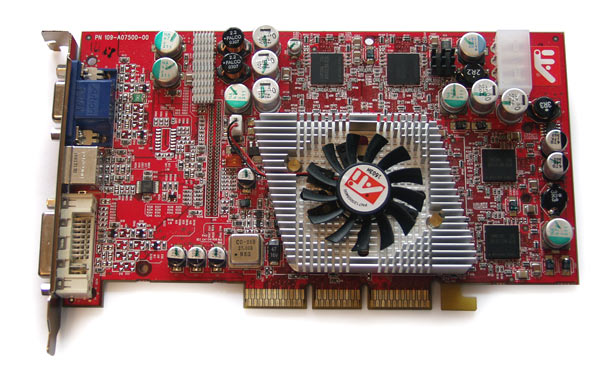
| ATI Radeon 9800 PRO 128MB Reference Board | |
| GPU | ATI RADEON 9800 PRO |
| Memory (Max) | 128 MB DDR SDRAM 2.8 ns |
| Memory/processor clock speed | 380/340(680) MHz |
| RAMDAC Frequency | 400 MHz |
| API | OpenGL, DirectX, Direct3D |
| Support for two monitors | Yes |
| Video Output | 2048 x 1536 / 60 Hz - 24-bit (16.7M colors) |
| Interface | AGP 8X |
| Ports and connector type | 1 x DVI-Analogue Digital - 29 pin DVI 1 x VGA - 15 pin HD D-Sub (HD-15) 1 x S-video output |
| Maximum resolution | 2048x1536 / 60 Hz |
This regular reference card of ATI is made on a red PCB which is already standard for ATI boards. What catches the eye first is the cooler. This design merits a special mention.
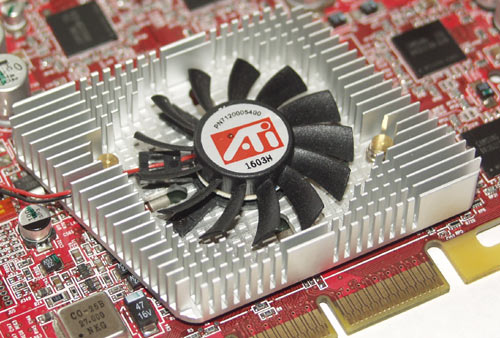
The cooler is made fully of aluminum, of parallelepiped shape, which already makes one wonder. The cooler radiator is cut into rather thin horizontal fins sawn vertically in the very center of the radiator where the fan is fit, which makes up sort of a square over the center and a needle-shaped radiator in that place. At the cooler base, under the fins of the fan there are four oblong holes - on top, below and on the sides. Due to these holes, the air flows hit the chip substrate and produce additional cooling. A most simple and well thought out solution for improving the cooling efficiency - a good bargain, isn't it?
Over the middle of the radiator's bottom surface there is a projection running through the whole radiator's length, well-polished at the joint with the chip. Therefore, the radiator is tightly fixed to the chip, and the protective frame causes no cooling issues any more, the way it used to be on some Radeon 9700 PRO specimen.
The noise level of the new cooler proved to be quite low, even lower than in the predecessor model, Radeon 9700 PRO.
The new cooler turned out to be well thought out, efficient and quiet; the loud-voiced FX Flow monster and other coolers for GeForce FX are simply beyond any comparison.
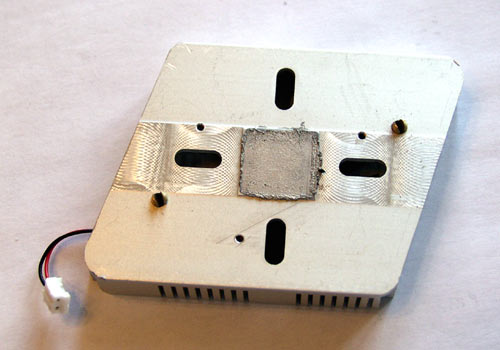
That silver thermo conductive paste Arctic Silver is used as the thermal interface between the cooler and the chip really good.
I was amazed by the fact that the same memory modules (Samsung 2,8 ns marked as K4D26323RA-GC2A) similar to those on the Radeon 9700 PRO are installed. This partly proves my assumption on the understated memory power supply voltage on the Radeon 9700 PRO which I had while testing the board. There are 8 memory modules as before, and what's surprising they are not cooled as before albeit heat up more intensely.
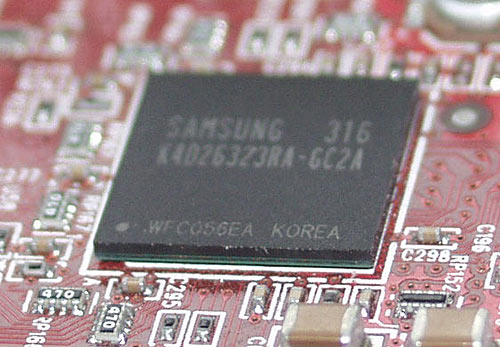
ATI seems to be reluctant about equipping the memory chips with radiators - that could have been of great use to the stability, and such solution isn't so costly. Well, ATI is huge and the company knows it better :).
Of course, additional power supply was used, and the onboard power connector is bit more handy than that on Radeon 9700 PRO - instead of the small four-pin Floppy connector there is a regular Molex, the way it is on the HDD or CD-ROM drive.
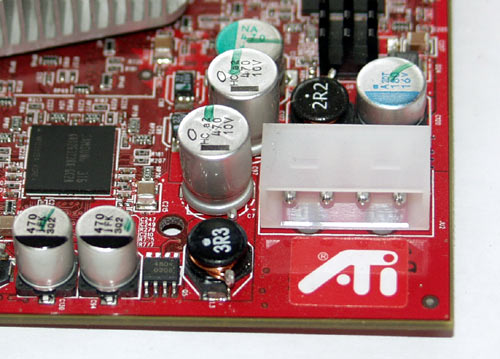
While breaking the fragile connector pins used to be easy, now you may forget about it.
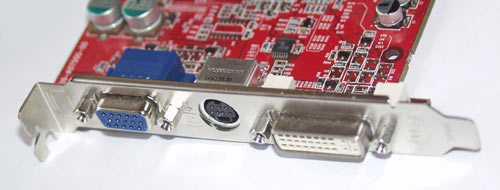
Since that is an ATI's reference board, you can't expect advanced package bundle. So, the board comes bundled with the following items:
In fact, you can't expect much from a reference board.
The card started up and was running stably at 450/750 MHz! The result is great, especially for the 0.15 mk process technology of the chip and the complete lack of cooling on the memory chips. The superb overclocking potentials of the chip points to one good thing - at ATI, the 0.15 mk process technology has been tuned to perfection and offers some margin for frequencies, which allows ATI to produce some more chips following the 0.15 mk process technology prior to migrating the higher-end chips to a new process technology.
The card produced a fantastic impression - the manufacturing quality and performance are up to the mark, and the overclocking potentials will certainly appeal to even the most exigent overclocker.
| Gigabyte GV-98256D 256MB | |
| GPU | ATI RADEON 9800 PRO |
| Memory (Max) | 256 MB DDR-II SDRAM 2.2 ns |
| Memory/processor clock speed | 380/350(700) MHz |
| RAMDAC Frequency | 400 MHz |
| API | OpenGL, DirectX, Direct3D |
| Support for two monitors | Yes |
| Video Output | 2048 x 1536 / 60 Hz - 24-bit (16.7M colors) |
| Interface | AGP 8X |
| Ports and connector type | 1 x DVI-Analogue Digital - 29 pin DVI 1 x VGA - 15 pin HD D-Sub (HD-15) 1 x S-video output |
| Maximum resolution | 2048x1536 / 60 Hz |
Like all the previously reviewed, this card is made on a red PCB. The main distinction of this board from the Radeon 9800 PRO 128MB is in the doubled capacity of onboard memory as well as in the use of DDR-II memory. This certainly has resulted in essential remake of the PCB - the number of chips has doubled and they are now positioned in an entirely different way - 4 chips on top and 4 chips sideways on each side of the board. There are 16 DDR-II memory chips onboard altogether, each cooled with a small needle-type radiator. That is a forced move, since the DDR-II memory chip heats up immensely at work, and even with the installed radiators the temperature of the chips is very high - you won't hold a finger on the radiator's chip longer than 10 seconds!
The chips themselves are made by Samsung and offer 2.2 ns access time, which is equivalent to 454(908) MHz. The rated memory frequency is 350(700) MHz.
Frankly, it's not quite clear what sense was in repeating NVIDIA's mistake in using the DDR-II memory, very sensitive to inductions. While NVIDIA gave up using the GDDR-II, ATI is still equipping its boards with memory of this type even though using the DDR-II does not give any essential performance boost as compared to the regular DDR. But, as the proverb says, come and have pot-luck with us :)
The cooler on the Gigabyte board is precisely the same as on the reference card, it differs only with a sticker but in fact it proved to run quieter than the "reference".
One of the memory chips is positioned too close to the board's cooler, that is why the radiator's edge was cut off. Cutting off the radiator does not deteriorate cooling of the chip at all, since there is a GPU cooler nearby, and air flows dispersed by the fan will hit the adjoining memory radiators as well. So there is no reason to worry about the stability.
In fact, there is nothing else the card stands out with, so let's move on to exploring the package bundle, which is worth it fortunately.
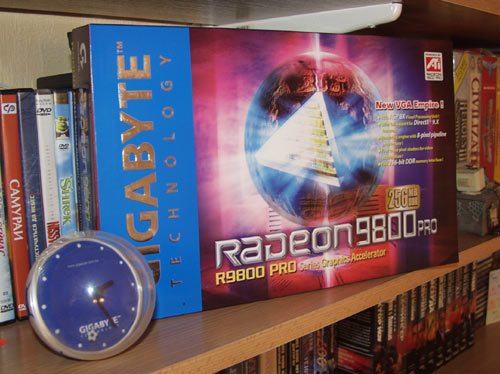
Let's start with the package. The card is packaged in a nice-looking box whose front wall opens up like a book. On opening the "book" you can see a list of the board's main features, some "vs. Radeon 9700 PRO benchmarking" diagram as well as a photo of the card with a visual enumeration of its components and options. The video card shown on the photo does not slightly match that put into the package - that is a 128 MB version of the Radeon 9800 PRO, but it's really nice anyway. Perhaps Gigabyte made such a package design to allow the buyer make himself aware of the main options of the card already on the way home :) I can imagine someone in the subway holding the open book with a Radeon 9800 PRO inside ...
Opening the box and remove ...
The bundled games merit a special mention. So the card comes bundled with licensed versions of the following games:
There are also demo versions of 4X4 Evolution and ONI on a separate CD.
Well, this card is definitely worth taking to a LAN Party :)
For overclocking its video card, Gigabyte offers its own utility - V-Tuner. The utility offers a simply and smart GUI - there are two sliders sideways of the window, with the first used for overclocking the chip and the other for overclocking the card's memory. In the middle, there are two speed meters showing the current frequency values. Under each of the slider there are four buttons: Go (apply settings), Default , Load and Save (revert to the previously taken frequency and save the current frequency value). The GUI of V-Tuner is intuitive, and even a rookie will handle it easily.
The video card's chip showed a pretty good overclocking result - 440MHz, with the memory results lagging behind a bit. Actually, you can't expect more from the DDR-II memory in view of its excessive sensitivity and high heat emission level.
All in all, the card left a very good impression - an excellent product, a very fast and well-made video card, with the package bundle up to the mark either. It's simply a pleasure holding such a video card on hands, and a real enjoyment trying it in action :)
Can you imagine the world's most powerful and absolutely noiseless video card? Especially those NVIDIA's roaring coolers for GeForce FX? Can you? But Sapphire Technology can - the company produced such a video card dubbed Sapphire Atlantis Radeon 9800 PRO Ultimate Edition! As the name suggests, this card is based on the GPU Radeon 9800 PRO and offers 256 MB onboard memory. So we are gladly presenting it.
| Sapphire Atlantis Radeon 9800 PRO Ultimate Edition 256MB | |
| GPU | ATI RADEON 9800 PRO |
| Memory (Max) | 256 MB DDR-II SDRAM 2.2 ns |
| Memory/processor clock speed | 380/350(700) MHz |
| RAMDAC Frequency | 400 MHz |
| API | OpenGL, DirectX, Direct3D |
| Support for two monitors | Yes |
| Video Output | 2048 x 1536 / 60 Hz - 24-bit (16.7M colors) |
| Interface | AGP 8X |
| Ports and connector type | 1 x DVI-Analogue Digital - 29 pin DVI 1 x VGA - 15 pin HD D-Sub (HD-15) 1 x S-video output |
| Maximum resolution | 2048x1536 / 60 Hz |
The cooling system of the board is made by ZALMAN, the manufacturer of world's quietest coolers. The system itself is made up of two massive aluminum radiators joined with a copper tube filled with some low-boiling-point fluid (such tubes are used by ABIT in their legendary OTES cooling system as well as by NVIDIA in its faulty FX Flow). The operation principle is simple - as the front radiator heats up, the fluid in the tube boils and transmits heat to the rear radiator of the card. To provide better heat transfer, thermal conductive paste is applied at the points of contact with the radiator. The radiators themselves are attached firmly to the board and one another, so you can safely forget about the concerns that the cooling system is poorly fastened or the nightmare dreams in which the radiator falls off during the gameplay.

As is known, there a fly in the ointment. Our case was no exception - forget about the couple of neighboring PCI slots: the problem is no longer topical nowadays when every normal motherboard offers at least 5 PCI slots. We ignore the Mini-ATX system, because Mini-ATX and Radeon 9800 PRO are incompatible by definition. Another shortcoming of this cooling system is the complete lack of air circulation near the memory chips which heat up immensely as we could make sure with the previously reviewed video card. Additionally, the radiators of the card heat up immensely during operation, which makes the air around the chip too hot and definitely not improves stability of the sensitive and capricious DDR-II memory. In fact, during those 6 hours of continuous operation not a single artifact or bug was detected - the card was as stable as rock.
On the board, I found connectors for plugging in the power supply of the cooler and a peculiar radiator cut on the chip closest to the GPU. This points to the fact that at the production stage there is no distinction between the regular and Ultimate versions of the cards - all the boards are within the same workflow, then they are equipped with regular coolers or the ZALMAN cooling system.

The board itself is made following the reference design and is absolutely identical to that previously reviewed video card made by Gigabyte. The boards differed only in the sticker on the rear side. At that, all mentioned about the Gigabyte board equally applies to the Sapphire video card. The box and the package bundle of the board merits a special mention. Which we'll be doing now.
Unlike its Radeon 9700 PRO-based predecessor, this card was packaged into a nice-looking smart and stylish black box.
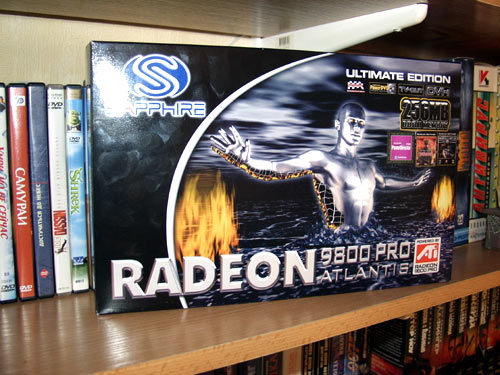
On the rear side, there is a viewing window through which you can see the card's cooling system - the box is simply a pleasure to hold such a card on hands. That applies to removing the contents:
It's always a pleasure to see fast and well-made video cards, and this one packaged in a nice box with a rich package bundle is twice as better. That's all about the card.
Like Gigabyte, Sapphire offers its own utility for fine optimization of the card - RedLine, with the only difference that the V-Tuner is designed for overclocking, while RedLine is meant for tweaking the card. This utility allows to finely tune the card's parameters as well as select one of the pre-set optimization profiles. RedLine offers profiles for most games and applications, e.g. 3DMark2001, RTCW, Q3, Medal of Honor, Max Payne.
This is very handy because you don't have to manually select the optimum settings for a specific application, and those who are into the settings internals can make use of the fine tuning for multiple parameters.
RedLine works with almost all ATI Radeon video cards, and the card doesn't have to be manufactured by Sapphire. For instance, I started RedLine absolutely safely on the Radeon 9800 PRO reference board.
All the parameters are gathered on several tabs. It's also possible to choose the operation mode for the utility - for novices or advanced users, and depending on the mode RedLine offers a respective set of options.
The graphic interface of RedLine is very easy to sort out, so I won't dwell on that.
The RedLine utility did appeal to me - it is a very easy-to-use and powerful tool for tuning and tweaking the video card.
We did not overclock the board. The reason is simple - this powerful video card offers a passive cooling system and it's not reasonable to expect good overclocking potentials from it. The guys at Sapphire did a good job without it and made the card absolutely noiseless, so the overclocking is out of the question. It will be possible provided additional cooling is installed, and that is not part of our testing plan.
| ATI Radeon 9700 PRO 128MB | |
| GPU | ATI RADEON 9700 PRO |
| Memory (Max) | 128 MB - DDR SDRAM |
| Memory/processor clock speed | 325/310 MHz |
| RAMDAC Frequency | 400 MHz |
| API | OpenGL, DirectX, Direct3D |
| Support for two monitors | Yes |
| Video Output | 2048 x 1536 / 60 Hz - 24-bit (16.7M colors) |
| Interface | AGP 8X |
| Ports and connector type | 1 x DVI-Analogue Digital - 29 pin DVI 1 x VGA - 15 pin HD D-Sub (HD-15) 1 x S-video output |
| Maximum resolution | 2048x1536 / 60 Hz |
The board is made on a red PCB. Despite its small bulk, the cooler is quite efficient and copes well with cooling a hot R300 chip.

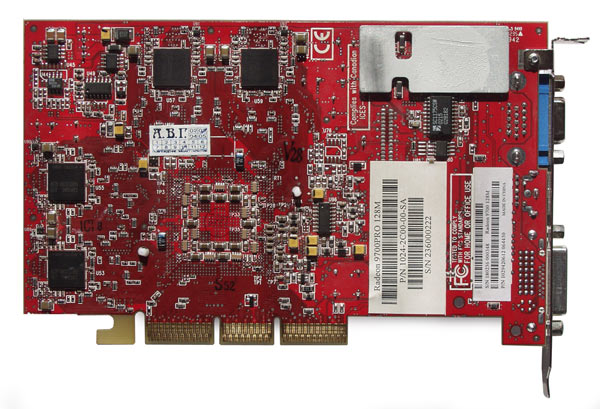
There are 8 memory chips wired on both sides of the card. The chips themselves are made by Samsung, BGA-packaged, and offer 2.8 ns access time, which is equivalent to 350(700) MHz. What was confusing a bit is the complete lack of memory cooling - it offers frequencies high enough and the memory heats up quite immensely - you won't hold a finger on the chip for longer than 15 seconds.
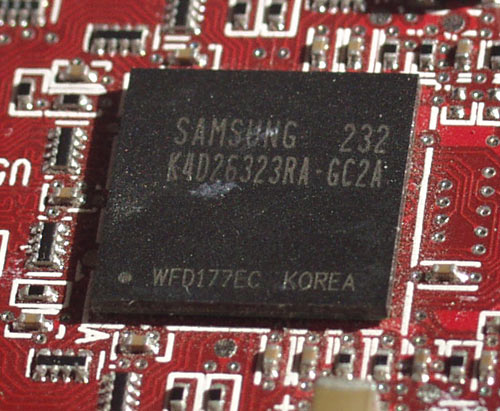
Upon removal of the cooler I found a protective frame around the chip meant for guarding the fragile chip against accidental splits. We quite often came across board specimens with the protective frame not installed evenly, which caused the radiator fit loosely to the chip, so the chip was overheating.
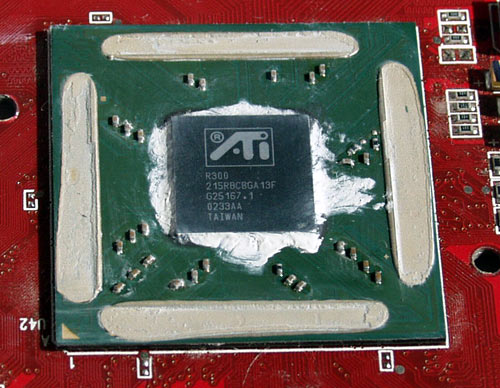
Our specimen is free from this problem - the frame is fitted evenly, and the cooler is pressed well. Like in the previously reviewed boards based on the Radeon 9800 PRO, there is silvery thermal conducting Arctic Silver paste applied between the cooler and the chip.
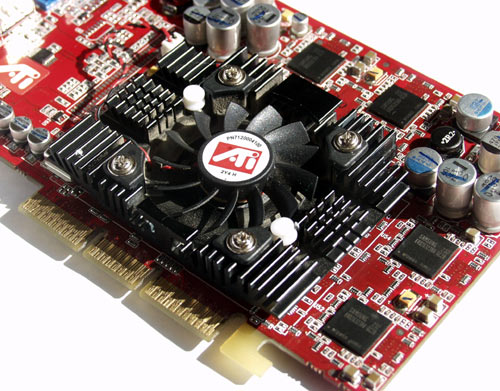
The board offers an additional power connector whose use is mandatory. With the power not applied to the connector, the card issues a black screen displaying a menacing warning that additional power is not supply and the card won't run without it.
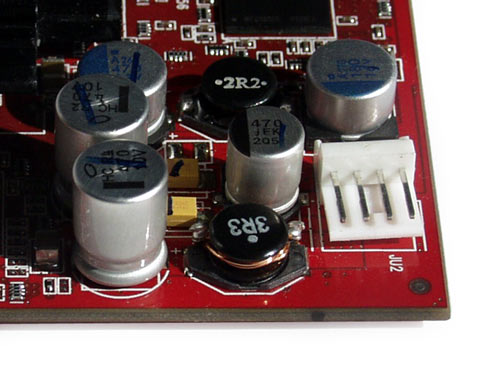
There is nothing else to note regarding the video card - it is a most regular, well-made card based on the Radeon 9700 PRO. Now on to the package bundle.
The board came without a box and was packaged into a regular antistatic package. Besides the board, the package included the following items:
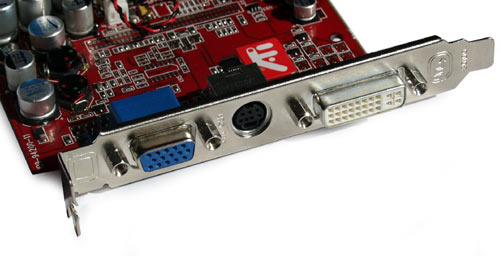
That's the kind of a scanty package bundle that one of the most powerful video cards to date offers. What to say to this? For the 300 USD they might have equipped the card with a good bundle - this isn't a mean GeForce2 MX or something, is it?
The card was running stably at 380/340(680)MHz for the memory and chip, respectively, without using additional cooling, which matches the operating speeds of Radeon 9800 PRO. The result is not bad at all for the 0.15 mk the chip is made on and the poor cooling system of the card. The memory was able running normally at the rated 700 MHz, which is normal for its access time. Quite probably, the power supply voltage is understated on the board, and that might be the reason for the poor overclocking of the memory.
On the whole, the card produced a good impression - it offers a good implementation and high operating speed. What spoils the scene is the scanty package bundle and the cooling system - if someone pays $300 for a video card, he is after a nice-looking box, rich package bundle and a good cooling system - not just a plastic bag with the card and a couple of wires inside. But the superb performance of the card makes up for all these shortcomings well enough.
So, why did we put the previous card into a review to do with the Radeon 9800 PRO? The thing is that some potentials of the Radeon 9800 PRO are implemented on the driver level. Alexey Nikolaichuk AKA Unwinder, the author of RivaTuner, released a patch (part of the RinaTuner 2.0 RC 12.4) that allows enabling all these options on the Radeon 9700 PRO. The patch speeds up the card's Device ID on the driver level, detects Radeon 9700 PRO as a Radeon 9800 and enables some optimizations inherent to Radeon 9800 PRO.
We conducted an interesting experiment: we overclocked the Radeon 9700 PRO 128MB up to the mark of Radeon 9800 PRO 128MB (380/680MHz), patched the drivers with the SoftR9800 and compared performance of the produced "almost Radeon 9800 PRO" with the fully functional Radeon 9800 PRO 128MB. As they say, if there's no difference, why pay extra?
| Test configuration: | |
| CPU | P4 2,4Mhz (Northwood D1) |
| Mb | Epox 4PDA2+ (i865PE) |
| Memory | PC3200 2x256MB in the dual-channel mode Timings set to 3:8:3:3 |
| Video cards | ATI Radeon 9800PRO 128MB (reference) Gigabyte GV-98256D based on the Radeon 9800PRO 256MB DDRII Sapphire Atlantis Radeon 9800 PRO Ultimate Edition 256MB ATI Radeon 9700PRO ASUS V9950 Ultra 256 Mb - FX5900Ultra (NV35) |
| OS | WinXP + SP1 |
| Drivers | Catalyst 3.6 |
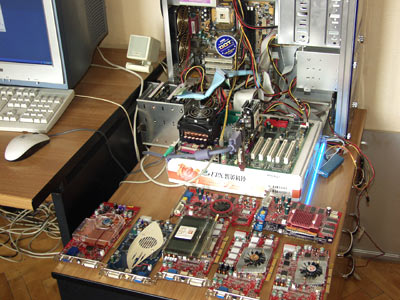
Benchmarking software used:
Along with the above reviewed video cards there was also the GeForce FX 5900Ultra 256MB made by ASUS - the fastest of all the FX family (the results marked in red). Also, remember that there are two results for the "ATI Radeon 9700PRO" presented - for the card 'as is" (light-green bars), with the second result for the card patched with SoftR9800 and overclocked to the 9800Pro level - 380/680 MHz (dark green).
Our testing session opens with the good old 3DMark2001.
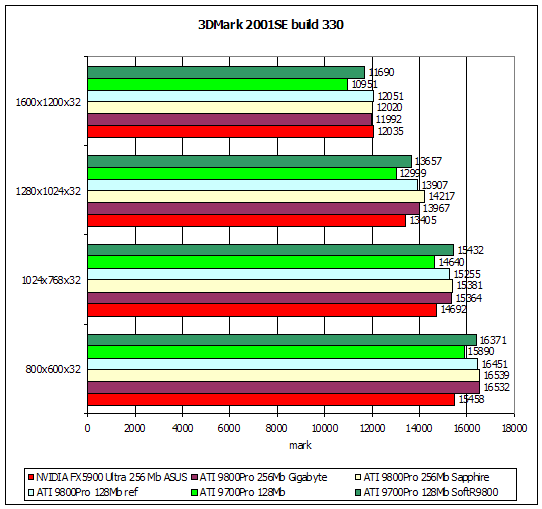
The picture proved quite interesting: at low resolutions, the GeForce FX5900Ultra took the last place; the card loses even to the "old" Radeon 9700 PRO. The latter revived due to overclocking and modified drivers, however paradoxically it may sound, takes a lead over the fully functional Radeon 9800 PRO! As the resolutions go up, the gap between the SoftR9800 and the full-featured brother grows wider, and at 1280x1024 the full-featured R9800PRO bypasses its younger brother. At that resolution, the GeForce FX5900 leaves the Radeon 9700PRO well behind, and at 1600x1200 the card wins an absolute leadership. The Radeon 9800 PRO 256MB performs practically on par with its 128 MB brother.
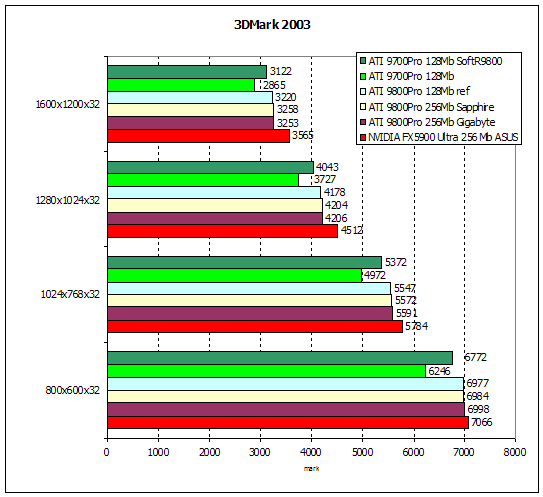
At this benchmark, the FX5900 somehow smoothly takes a sure lead followed by the Radeon 9800PRO, with the SoftR9800 and R9700PRO lagging behind.

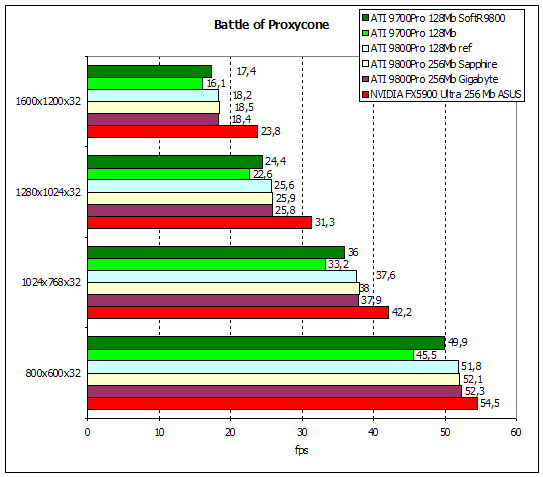
At this benchmark, the FX5900 leaves all the rivals behind, quite immensely, I must admit. Things are more or less predictable with the other video cards.

At low resolutions, the FX5900 is practically on par with the SoftR9800, then the FX starts overtaking its rivals and takes a sure lead at high resolutions. The R9800 PRO brothers go abreast with one another at all the resolutions.
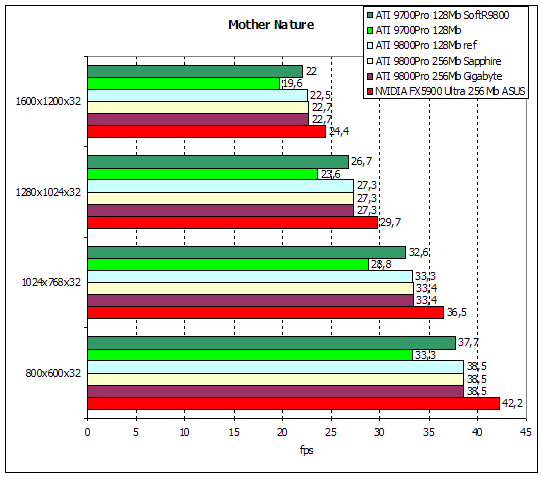
Of all the 3DMark'2003 family, this benchmark is the most resource-hungry, and at that the FX5900 demonstrates its undisputable leadership. The apportionment among the other cards stayed as before.
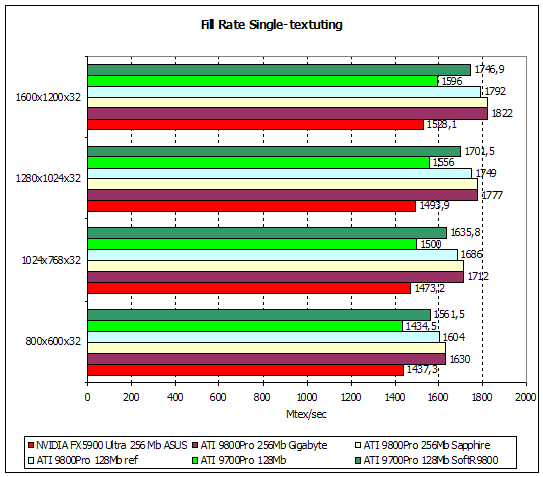
At single-texturing, the Radeon 9800PRO is beyond competition, with the FX lagging in the tail giving in to even the Radeon 9700 PRO.
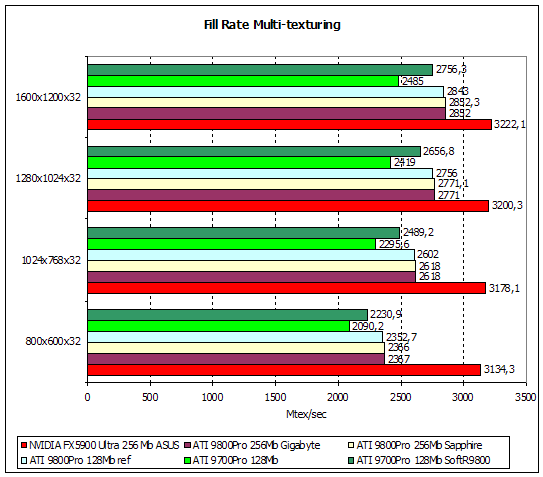
At this benchmark, all is reverse - the FX rules.

At that benchmark, all the three Radeon 9800 PRO-based video cards go abreast and show absolutely identical results regardless of the memory capacity. The SoftR9800 lags behind them by a tenth of fps, then there goes the FX, with the "old man" R9700PRO coming the last.
So many times the situation is familiar - at low resolutions, the FX lags behind, and as resolutions go up it is overtaking the rivals to win an absolute leadership at high resolutions.

The FX takes a sure lead at 1600x1200, but it lags at low resolutions even behind the Radeon 9700 PRO, quite noticeably.
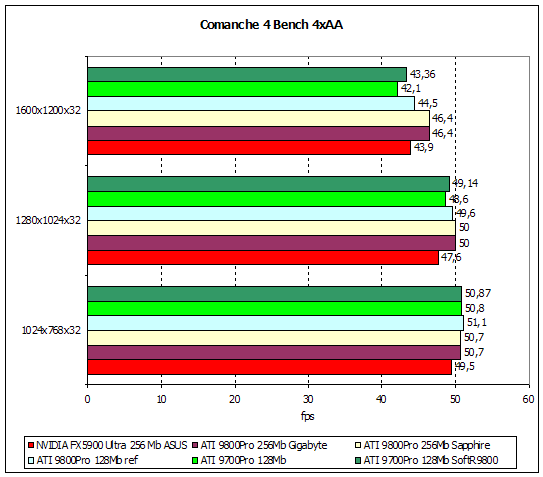
The FX takes the last position at all the resolutions except 1600x1200 where it was anyway able to overtake the R9700PRO.

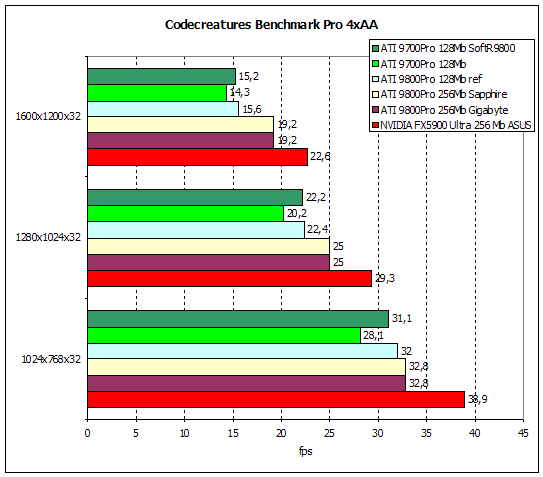
This is the only benchmark that shows a vivid difference among the results shown by the ATI Radeon 9800Pro 128 and 256Mb version, and the gap grows wider as the resolution goes up. The undisputable leadership at this super-hard benchmark is taken by the FX.
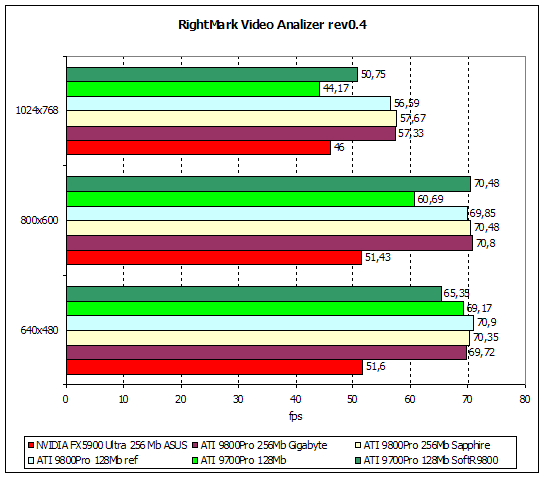
The picture is absolutely identical to that observed in the Comanche 4 benchmark: the FX5900Ultra was able to overtake the R9700PRO only at 1600x1200, and at all the other benchmarks this card proved to be an absolute outsider.


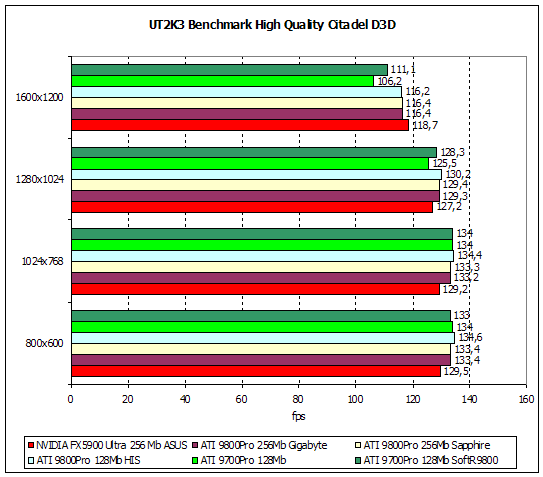
At all the three benchmarks, the FX lags behind the R9800PRO at low resolutions and takes a lead at high. The Radeon 9800 PRO brothers perform practically abreast, with the SoftR9800 lagging behind them a little bit.


The picture observed in this benchmark is practically identical to that in UT2003 - at low resolutions the FX falls behind and wins the leadership back at high resolutions.
The conducted tests allow to make the following conclusions:
So, what is in the upshot? As a result, the Radeon 9800 PRO 128MB proves to be the most balanced of all the reviewed video cards - the board shows a stable operation at all the tests, is not second to the 256 MB Radeon 9800 PRO, and in many tests it overtakes the much more expensive GeForce FX 5900 Ultra.
|
|||||